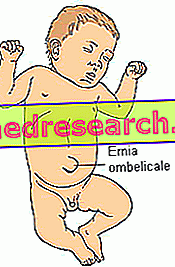Definition of umbilical hernia
The umbilical hernia is a bulge towards the outside of the abdominal lining - or a part of the organ contained in the cavity of the abdomen - through the navel.

Different discourse must be posed for the umbilical hernia in the adult: in this case, we speak of herniation from "weakness of the abdominal muscles", caused by the increase in intra-abdominal pressure (ascites, cirrhosis, multiple pregnancies, tumor in the abdominal cavity and obesity).
The umbilical hernia in the adult almost always requires surgery.
Symptoms
In small umbilical hernias, pain is a recurrent symptom, always accompanied by obvious swelling and localized burning. Pain can be exacerbated by coughing, sneezing or lifting heavy loads. Even the standing position, maintained for a long time, can aggravate the symptoms.
To the touch, the swelling is soft or more nodular and rigid, depending on the severity of the condition. The skin covering the umbilical hernia appears swollen and reddened; sometimes the color of the umbilical skin varies from gray to bluish.
Some patients suffering from umbilical hernia also complain of some dyspeptic and intestinal disorders.
In the young child, the volume of the hernia tends to increase during crying and during exertion, an expression of intra-abdominal pressure increase.
Complications
In infants and young children, affected by umbilical hernia, complications are extremely rare, unless the condition is linked to very serious underlying pathologies.
In the adult, however, the umbilical hernia not properly treated can create serious complications:
- Incarcerated hernia: the protruding abdominal tissue remains "trapped", therefore it cannot return to its natural position. In this case, the patient may experience serious disorders: intestinal obstruction, fierce abdominal pain and vomiting are the most recurrent complications.
- Choked umbilical hernia: complication even more serious than the previous one since the intestinal blood supply is completely denied. In this condition, a tract of the intestine is literally choked: the patient complains of excruciating and unbearable abdominal pains, associated with vomiting and complete bowel obstruction. Death occurs by tissue gangrene and by rapid diffusion of the infection in the other sites of the body.
Diagnosis
The diagnosis of small umbilical herniation is quite simple and does not present particular difficulties (except for small hernias arising in obese patients).
In normal weight patients, a suspicion of umbilical hernia is confirmed by simple observation and medical palpation, accompanied by anamnestic analysis:
- Observation of the umbilical site of the lesion
- Tendency of the hernia to increase in size during standing
- Increased abdominal pain with a cough or sneeze
When necessary, the doctor can subject the patient to more thorough diagnostic tests (X-ray or ultrasound imaging tests).
The differential diagnosis must be made with omphalitis, umbilical and periombelical tumefactions (eg lipomas) and umbilical neoplastic metastases.
therapies
In general, infant umbilical hernias - especially if small in size - do not present any particular gravity: they tend to regress spontaneously within 12-18 months of life. Sometimes, the doctor can stimulate healing by wrapping the abdomen of the child suffering from umbilical hernia with elastic-containing bandages: this method seems to reduce the lateral tension of the abdominal wall, so the swelling is reduced more quickly.
Some ancient folk remedies aimed at favoring recovery from the umbilical hernia suggested inserting a coin into the umbilical groove, and fixing it to the abdomen with adhesive tape. This practice, however, does not seem to be very effective for healing; on the contrary it is potentially harmful because germs, accumulating under the coin, can create infection.
When is surgery necessary to treat umbilical hernia in the child?
In the newborn and small child, the surgical procedure may be indispensable in the following cases:
- Umbilical hernia is extremely painful
- The diameter of the hernia is more than 2 cm
- The size of the umbilical hernia does not reduce after 6-12 months from the manifestation of the very first symptoms
- The umbilical hernia still persists at the age of 3 years
- Medical bandaging does not promote any improvement in symptoms
- Complicated umbilical hernia (choked or imprisoned)
Alternative therapies
For adults suffering from umbilical hernia and for children who are unable to heal spontaneously or with bandages, it is possible to proceed with an umbilical skin incision. The procedure, performed under local anesthesia, is performed by making an incision near the umbilical orifice. The incision must be traced at least 1 cm from the navel to minimize the risk of damaging the normal vascularization. Subsequently, the bulge is pushed inwards. After closing the wound, the patient can return home the day of the operation.
After surgery, you can administer paracetamol or ibuprofen to calm the pain; Acetylsalicylic acid is also an excellent pain reliever, but should not be given to children under the age of 12.
The prognosis is almost always excellent and it is however unlikely that the umbilical hernia will occur more than once in life.



